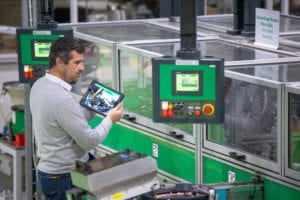In the commercial and industrial sector, the digital transformation race is on, with companies adopting Industry 4.0 technologies in an effort to increase quality and productivity, and to more quickly respond to customer demands. To compete, companies need to deploy reliable, secure edge computing capacity, a requirement that a micro data center infrastructure is well-suited to meet.
Industry 4.0 is inherently technology-driven. It involves Internet of Things applications that collect data from all sorts of machines and devices in an effort to improve productivity, increase efficiency and streamline processes, to name a few benefits. IIoT applications also support preventive maintenance initiatives that increase uptime and reduce costs.

Data, data everywhere
It’s hard to overstate the scale of the effort. The research firm IDC predicts 40 billion connected “things” will generate nearly 80 zetabytes (ZB) of data in 2025. The amount of data created by connected IoT devices will see a compound annual growth rate (CAGR) of 28.7% over IDC’s forecast period of 2018 to 2025, but the industrial and automotive categories will grow at more than twice that clip – 60%, IDC says.
We’re talking about enormous amounts of data. A Cisco blog post from 2016 (when we first crossed the ZB threshold in terms of Internet traffic) did a nice job of providing perspective. Consider that a single ZB is equal to one billion terabytes (TB) of data. If each TB in a ZB were a kilometer, it would be equivalent to 1,300 round trips to the moon and back, each clocking in at 768,800 kilometers. (See the Cisco post for more fun comparisons.)
When you have such massive quantities of data, you need local compute power to process it for at least a couple of reasons. For one, it’s not practical to send large quantities of data to a faraway cloud data center for processing and, two, the latency involved would be at odds with the real-time nature of many IIoT applications.
Key attributes of an edge data center
So commercial and industrial firms need local, edge data centers to support their Industry 4.0 and digital transformation efforts. The question, then, is how best to build such data centers. The three following considerations leap to mind:
- Edge data centers often have to live within the confines of an existing commercial or industrial space, be it a retail store, manufacturing facility or even an outdoor location, such as for a utility. That cries out for an all-in-one solution, where compute, storage and networking equipment can be installed in a self-contained enclosure. Hyperconverged infrastructure is ideal for edge data centers, especially when delivered in a micro data center enclosure that also includes all power and, if necessary, cooling components.
- Security is paramount. Although small by nature, edge data centers nonetheless play a big role in supporting important business objectives like digital transformation. From a security perspective, they must be treated much the same as centralized data centers. That means providing physical security, including continuous video monitoring to detect and prevent unauthorized access, as well as environmental monitoring to warn against extreme heat, cold, and moisture.
- Remote management is likewise crucial, because in many, if not most, cases no IT staff will be on site to monitor and manage the edge data center. So, IT staff need to be able to monitor edge data centers from a centralized location. You earn bonus points if your solution includes cloud-based preventive maintenance services to help predict and thwart failures before they happen.
Micro Data Centers for any application
Micro data center enclosures provide a way to meet all of these requirements in a simple, easy to deploy fashion. Explore our Micro Data Center page to peruse the options and find the model that best suits you. You can also contact one of our partners to determine which model is best for you, based on the exact components you need. You can even have it all assembled with supporting infrastructure and shipped to the site of your choice in our shock packaging. In no time you can have a micro data center that’s ready to load with IT gear and support your digital transformation efforts.



